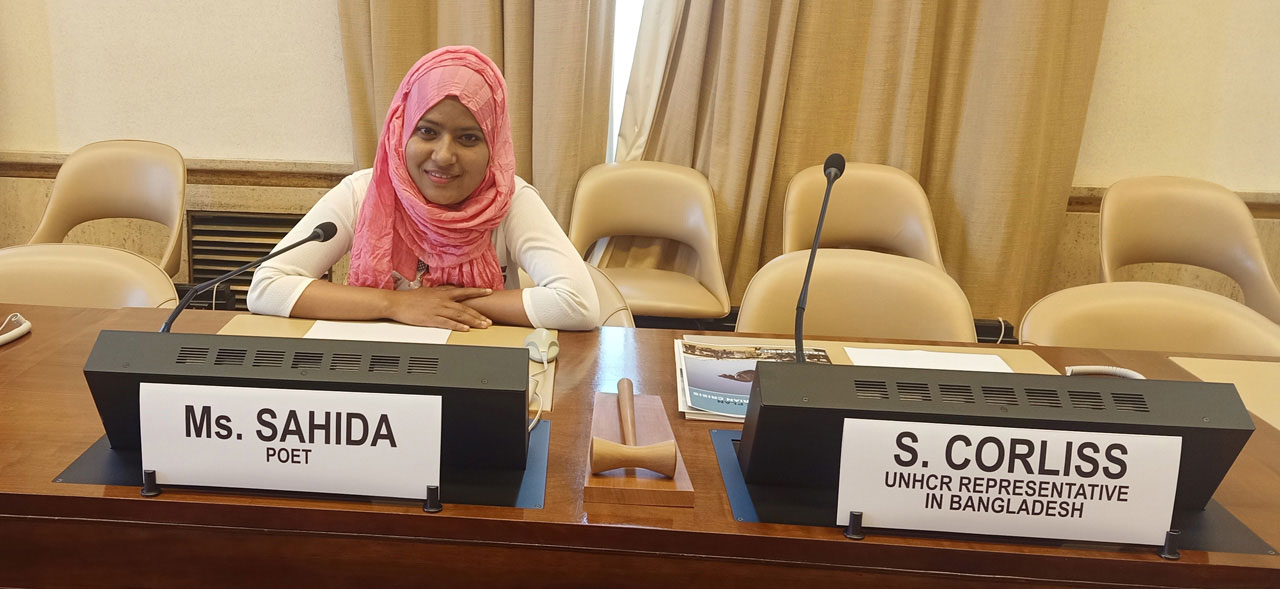
A Rohingya Poet Speaks
I have been working with the Rohingya Cultural Memory Centre (RCMC) as a Cultural Agent from the project’s beginning.
– Shahida Win, Rohingya poet
My name is Shahida. I am a Rohingya poet and refugee in the world’s largest refugee camp, Cox's Bazar, Bangladesh. I have been working with the Rohingya Cultural Memory Centre (RCMC) as a Cultural Agent from the project’s beginning. I would like to share you about the centre, its activities, and some of my invaluable experiences as a Cultural Agent for the RCMC.
WHY DO WE NEED A CULTURAL MEMORY CENTRE?
The Rohingya are an ethnic group from Rakhine State, Myanmar. We have our own language, traditions and cultures. The United Nations once called us “the most persecuted minority in the world.” As Rohingya are persecuted at our homeland, many of us fled to other countries. Almost one million are now living in Bangladesh as refugees. It is very important for a community to maintain their cultural heritage, but ours is now becoming endangered. It needs to be preserved for new generations of Rohingya to know their own traditions and cultures.
The Rohingya Cultural Memory Centre is a community space that works to preserve endangered Rohingya traditions, cultures, rituals, rites and arts.
Many Rohingya refugee artists, researchers, craftsmen, poets, storytellers, singers, musicians, artisans, photographers, painters, cultural practitioners, traditional cooks, carpenter and others with knowledge of Rohingya culture and arts have been engaged to research, document, produce and reproduce our own heritage. This centre thus provides us a platform to maintain our vital Rohingya arts and culture. It gives us an opportunity to express our creativity, aspirations, memories and feelings through our arts. It also helps us relieve the stress of living as refugees, forcibly displaced from homeland. Our artwork, especially our music, can play a key role in reducing stress and bringing smiles to our faces.
Working as a Cultural Agent has been a great opportunity to research and learn about our heritage.
I learned many things about Rohingya traditions and cultures that I did not know before, and got a chance to work with many talented Rohingya refugee artists, artisans, cultural practitioners and researchers. I collected and wrote many posts about Rohingya traditional foods and recipes, traditional games, traditional dresses, modern and ancient jewellery, Rohingya stories and folk tales, different kinds of veils worn by Rohingya women, and many other topics. I have also written about the lives of Rohingya people in Arakan. Poetry is my passion, and I wrote poems in Burmese (which have been translated to English) and visual poetry in Rohingya, Burmese and English. Through my poetry, I want to let the Burmese government and international community know about the sufferings of my people. Through spreading awareness by art, I wish to end the cycle of persecution.
ART CREATES BELONGING
The arts have a long history of bringing people together, despite differences in nation, religion, race or creed.
Art fosters community by creating new opportunities for collaboration and understanding. Community-based arts practitioners unite people to solve problems, build loving relationships, and find ways of peaceful coexistence with other communities.
For me, my Rohingya heritage is a constant source of inspiration. Through understanding Rohingya culture and traditions, I can better understand our history. And, through art, I have opportunities to showcase my knowledge and talents, and share my voice with the world. Through my art, I can tell the world: We want to live peacefully on our motherland again with human dignity. We only want safety, freedom, peace and equal rights. I want girls and women in my community to be treated respectfully and given equal rights.
Having our own Rohingya Cultural Memory Centre is an invaluable gift for the entire Rohingya community. It is our very own Rohingya art and cultural treasure house, supporting us to create, maintain and share our own stories. I invite you to visit our centre where you will find many artworks worth seeing.
* * *
Written by Shahida Win, poet and Cultural Agent at the Rohingya Cultural Memory Centre.
WORKS BY SHAHIDA WIN
